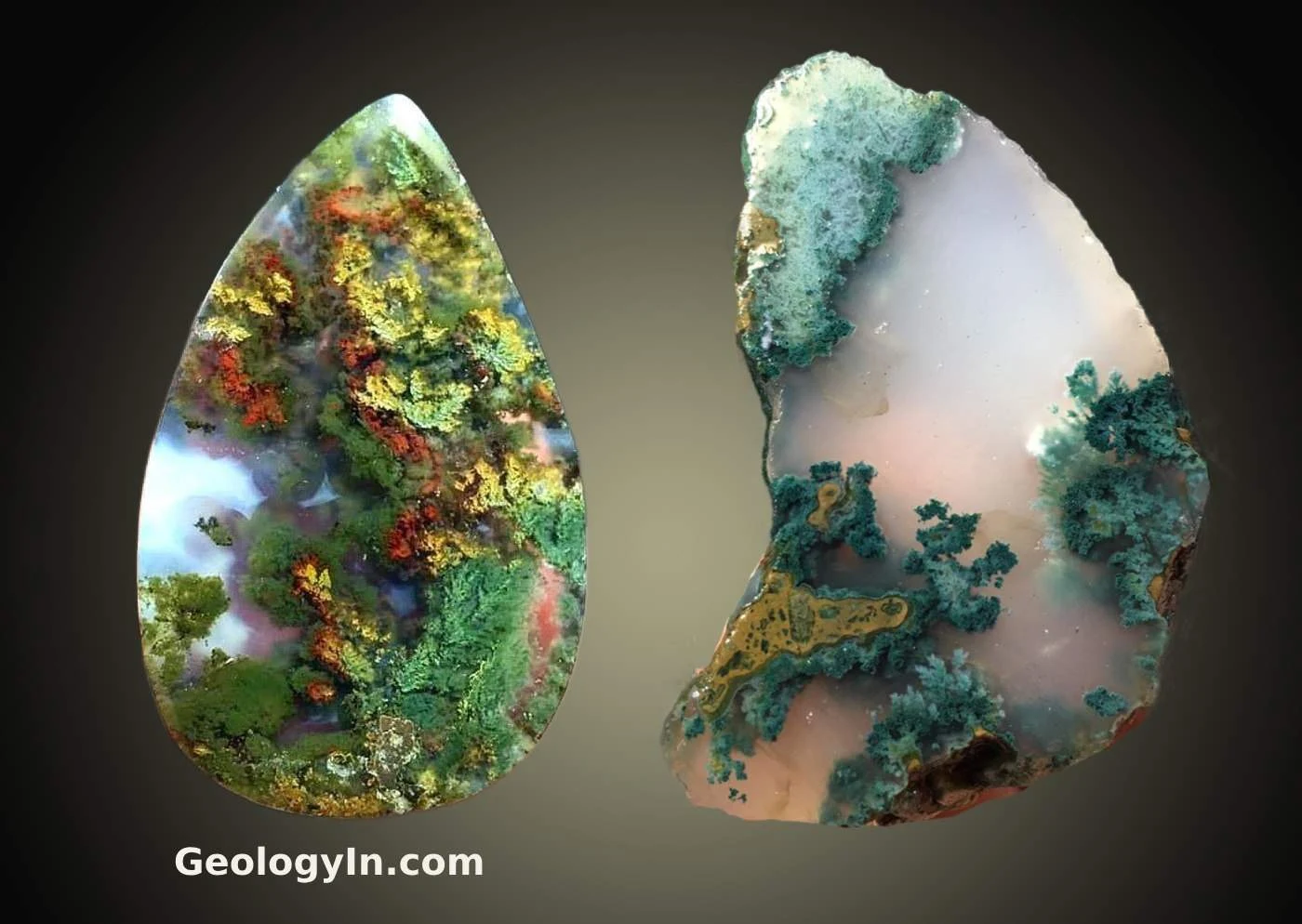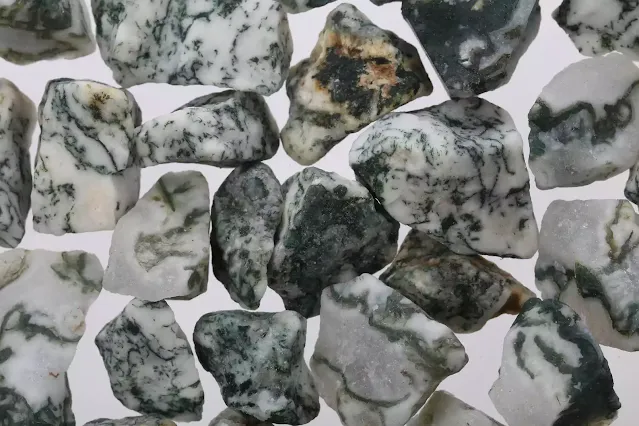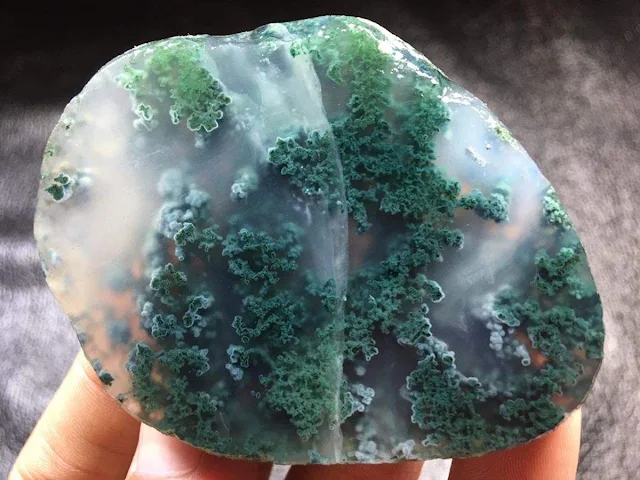Moss Agate: Formation, Occurrence, Uses
Moss agate is a variety of agate characterized by its moss-like inclusions, resemble moss, ferns, or other plant-like forms. These inclusions are primarily formed by manganese oxide or iron oxide, imparting the agate with shades of green, brown, or black against a backdrop of milky white or clear quartz.
Moss Agate: Nature's Artistry in Stone
This semi-precious gemstone, a member of the chalcedony family—a microcrystalline type of quartz—derives its name from these dendritic, or branching, mineral formations that resemble a miniature forest scene. Unlike many other agates, Moss Agate does not typically feature banding.
The alternative name " Mocha stone" Or "Mocca Stone" comes from the Arabian city of Mocha in Yemen, which was an ancient source for the gemstone.
 |
| Moss Agate |
Formation: How Does Moss Agate Form
Moss Agate formed through a fascinating geological process that involves silica-rich solutions and mineral inclusions. Let's delve into the intricate steps that give rise to this captivating gemstone.
1. Volcanic Activity and Silica-Rich Waters:
The journey of Moss Agate begins amidst volcanic activity, where hydrothermal vents release silica-rich fluids. These fluids, laden with dissolved silicon dioxide (SiO₂), permeate the surrounding rocks, often volcanic in nature.
2. Filling Cavities with Silica Gel:
As the silica-rich fluids seep through the porous rocks, they encounter cavities or cracks. These spaces become the canvas for the formation of Moss Agate. The silica gel, a gelatinous form of SiO₂, gradually fills these cavities, layer by layer.
3. Mineral Inclusions and Dendritic Patterns:
During the silica gel deposition process, various minerals, such as manganese oxide or iron oxide, get incorporated into the gel. These minerals, responsible for the moss-like patterns, are deposited in a dendritic form, resembling delicate branches or fronds.
4. Slow Crystallization and Agate Formation:
Over time, the silica gel slowly crystallizes, transforming into chalcedony, the primary component of Moss Agate. The dendritic inclusions, now embedded within the chalcedony, create the intricate moss-like patterns that define this gemstone.
 |
| Moss Agate from Java, Indonesia Photo: Fraska_dailyseller |
Properties of Moss Agate
Color: Moss Agate is typically green, with shades ranging from pale green to deep forest green. The green color is caused by inclusions of manganese oxide or iron oxide. Moss Agate can also have brown, black, or white inclusions.
Transparency: Moss Agate is translucent to semi-translucent. This means that light can pass through it, but the stone is not completely clear.
Luster: Moss Agate has a waxy to vitreous luster. This means that it has a dull to glassy shine.
Hardness: Moss Agate has a hardness of 6.5 to 7 on the Mohs scale of mineral hardness. This means that it is a relatively hard stone and can scratch glass.
Density: Moss Agate has a density of 2.58 to 2.64 g/cm³. This means that it is a relatively dense stone.
Crystal system: Moss Agate has a trigonal or monoclinic crystal system. This means that its crystals have three or two axes of symmetry.
Chemical composition: Moss Agate is composed of silicon dioxide (SiO₂) with inclusions of manganese oxide or iron oxide.
 |
| Moss Agate |
Is Moss Agate organic
Despite its name, moss agate does not contain organic matter and is usually formed from weathered volcanic rocks. The colors are formed due to trace amounts of metal present as an impurity, such as chrome or iron.
Is Moss Agate Real Agate
Moss Agate is considered a type of agate in the gemstone world, but unlike typical banded agates, it features green, moss-like mineral inclusions within a chalcedony base, rather than banding. Thus, while it's called an agate, it doesn't conform to the strict mineralogical definition of agate.
 |
| Moss Agate From Indonesia |
Where does moss agate come from
Occurrence and Distribution of Moss Agate is found in various regions around the world, often occurring in areas with volcanic activity. Notable sources of Moss Agate include:
India: India is a renowned source of Moss Agate, particularly in the state of Gujarat. The Indian Moss Agate is known for its intricate patterns and vibrant colors, ranging from deep greens to earthy browns.
Brazil: Brazil is another significant producer of Moss Agate, with deposits found in the states of Rio Grande do Sul, Minas Gerais, and Bahia. Brazilian Moss Agate is known for its diverse range of colors, including shades of green, brown, yellow, and even red.
Uruguay: Uruguay is a notable source of Moss Agate, particularly in the Artigas department. Uruguayan Moss Agate is known for its distinctive patterns, often resembling delicate branches or fronds of moss.
Indonesia: Moss Agate from Indonesia, particularly from regions like Java, has been noted for its quality. The Indonesian variety often features in discussions and collections for its unique patterns, where the "moss" within the agate is formed by iron and other mineral inclusions, giving it a forest-like appearance.
United States: In the western United States, Moss Agate is found in various states, including Montana, Wyoming, Oregon, Washington, and Idaho. Montana, in particular, is known for producing high-quality Moss Agate with intricate patterns and vibrant colors.
Central European countries: Several central European countries, including Germany, Poland, and the Czech Republic, have deposits of Moss Agate. European Moss Agate is known forits earthy tones and well-defined patterns.
Moss Agate typically occurs as nodules or pebbles within volcanic rocks, often found in alluvial gravels or streambeds. The specific locations of Moss Agate deposits may vary depending on the region and geological conditions.
 |
| Types of Moss Agate, Green Moss Agate, Red Moss Agate, Dendritic Agate, Snowflake Moss Agate |
Types of Moss Agate
Moss agate comes in various forms, each distinguished by its appearance, the nature of its inclusions, or its color. Here are some common variations or types of moss agate based on their appearance and composition:
Green Moss Agate: This is the most common type of moss agate and is characterized by green, plant-like inclusions. The green color is usually due to chlorite or other mineral inclusions resembling moss, leaves, or landscapes.
Red Moss Agate: Contains red or brownish-red inclusions, often due to iron oxides, giving it a warm appearance alongside or instead of the green moss.
Dendritic Agate: Often confused with or categorized alongside moss agate, dendritic agate has tree or fern-like inclusions (dendrites) which are usually black or brown, created by manganese or iron oxides. When these dendrites look particularly moss-like, the stone might be labeled as moss agate.
Tree Agate: Although sometimes considered a separate stone, tree agate is often grouped with moss agate due to its similar appearance. It has white or off-white chalcedony with green dendritic patterns resembling trees or branches.
Plume Agate: Sometimes confused with moss agate, plume agates have feather-like or plume structures. However, when these plumes resemble moss or are very fine, they might be referred to under the moss agate umbrella.
Indian Moss Agate: Known for its vivid green and sometimes red or yellow inclusions, it's prized for jewelry due to its vibrant colors.
Mocha Stone: Another name sometimes used for moss agate, particularly when the inclusions give a coffee or chocolate color appearance.
Snowflake Moss Agate: Features white or light-colored "snowflake" patterns against a darker or more translucent background, providing a stark contrast.
Each piece of moss agate is unique due to the natural patterns formed by the inclusions, making it a highly sought-after stone for collectors and jewelry makers.
 |
| Moss agate is made of chalcedony (a form of quartz) with inclusions of manganese or iron oxides that create the moss-like patterns. |
Uses of Moss Agate
Moss agate is a versatile gemstone with a wide range of uses, from its primary application in jewelry to its role in mineral collections, decorative pieces, and alternative healing practices.
Jewelry: Moss agate is primarily used in jewelry, where its captivating patterns and vibrant colors enhance various designs. It is often crafted into necklaces, pendants, earrings, bracelets, and rings, adding a touch of nature and earthy elegance to any piece.
Mineral Collection: Mineral enthusiasts and collectors highly value moss agate due to its rarity, beauty, and geological significance.
Decorative Objects: Moss agate can be transformed into decorative objects, adding a touch of natural beauty and elegance to any space. It is often crafted into paperweights, bookends, sculptures, and other decorative accents.
Alternative Healing Practices: In some alternative healing practices, moss agate is believed to possess healing properties. It is associated with promoting creativity, intuition, and transformation, and some believe it can enhance mental clarity and emotional balance. Moss agate is often used in meditation and crystal healing practices, with individuals believing it can promote inner peace and harmony.
Moss agate's captivating beauty, rarity, and diverse uses make it a cherished gemstone, adding a touch of nature's artistry to everyday life and various practices.
Conclusion








%20(1).webp)